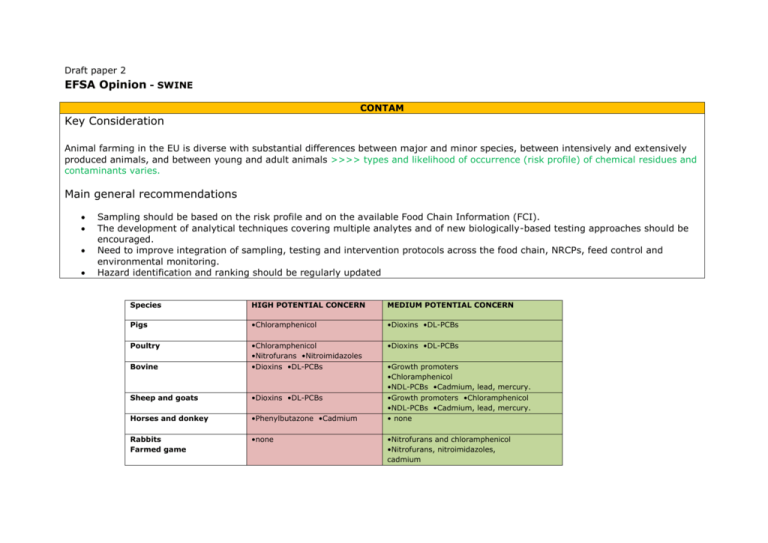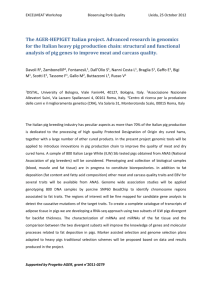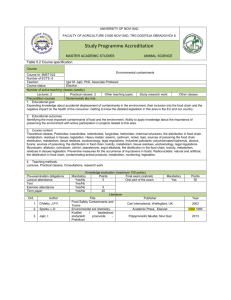Draft paper 2 EFSA Opinion - SWINE CONTAM Key Consideration
advertisement

Draft paper 2 EFSA Opinion - SWINE CONTAM Key Consideration Animal farming in the EU is diverse with substantial differences between major and minor species, between intensively and extensively produced animals, and between young and adult animals >>>> types and likelihood of occurrence (risk profile) of chemical residues and contaminants varies. Main general recommendations Sampling should be based on the risk profile and on the available Food Chain Information (FCI). The development of analytical techniques covering multiple analytes and of new biologically-based testing approaches should be encouraged. Need to improve integration of sampling, testing and intervention protocols across the food chain, NRCPs, feed control and environmental monitoring. Hazard identification and ranking should be regularly updated Species HIGH POTENTIAL CONCERN MEDIUM POTENTIAL CONCERN Pigs •Chloramphenicol •Dioxins •DL-PCBs Poultry •Dioxins •DL-PCBs Bovine •Chloramphenicol •Nitrofurans •Nitroimidazoles •Dioxins •DL-PCBs Sheep and goats •Dioxins •DL-PCBs Horses and donkey •Phenylbutazone •Cadmium Rabbits Farmed game •none •Growth promoters •Chloramphenicol •NDL-PCBs •Cadmium, lead, mercury. •Growth promoters •Chloramphenicol •NDL-PCBs •Cadmium, lead, mercury. • none •Nitrofurans and chloramphenicol •Nitrofurans, nitroimidazoles, cadmium CONTAM TOR 1 ID + rank main risks for PH that should be addressed by MI at EU level. General (e.g. sepsis, abscesses) and specific biological risks as well as chemical risks (e.g. residues of veterinary drugs and contaminants) should be considered. Differentiation may be made according to production systems and age of animals (e .g. breeding compared to fattening animals) TOR 2 Assess strengths & weaknesses of the current MI methodology & recommend possible alternative methods (at AM or PM inspection, or validated laboratory testing within the frame of traditional MI or elsewhere in the production chain) at EU level, providing an equivalent achievement of overall objectives; the implications for AH/AW of any changes suggested in the light of PH risks to current inspection methods should be considered TOR 3 If new hazards currently not covered by the MI system (e.g. Salmonella, Campylobacter) are identified under TOR 1, then recommend inspection methods fit for the purpose of meeting the overall objectives of MI. When appropriate, FCI should be taken into account. TOR 4 Recommend adaptations of inspection methods and/or frequencies of inspections that provide an equivalent level of protection within the scope of MI or elsewhere in the production chain that may be used by risk managers in case they consider the current methods disproportionate to the risk, e.g. based on the ranking as an outcome of terms of reference 1 or on data obtained using harmonised epidemiological criteria. When appropriate, FCI should be taken into account. CONCLUSIONS • Chemical residues & contaminants in slaughter animals are unlikely to pose an immediate or short term health risk for consumers. However, certain bioaccumulating contaminants are of potential concern because they will contribute to the overall exposure. In addition, the presence of chemical residues of certain PASs may be of potential concern as they are indicative either of non-compliance with existing regulations or of illicit use of nonauthorized substances, with implications for risk management. •The Panel considered all substances listed in Council Directive 96/23/EC and evaluated the outcome of the residue monitoring plans for the period 2005-2009. Available aggregated data indicate the numbers of samples that were non-compliant with the current legislation. However, in the absence of substance-specific information, such as the tissues used for residue analysis and the actual concentration of a residue or contaminant measured, these data do not allow a reliable assessment of consumer exposure. • Other criteria used for the identification and ranking of chemical substances of potential concern included the identification of substances that bio-accumulate in the food Strengths • Current MI facilitates tissue sampling for the analysis of residues of contaminants, VMPs and non-authorized substances as listed in Council Directive 96/23/EC • Current procedures of sampling and testing are well-established and involve a regular evaluation of analytical procedures in all EU Member States addressing the performance of analytical methods. • There are well-developed systems and follow-up mechanisms following identification of noncompliant samples. Follow-up on non-compliant samples is typically through intensified sampling (suspect sampling), withholding of carcasses or pigs with the same history for slaughter, subject to positive clearance as compliant, and on-farm investigations potentially leading to intervention, penalties and/or prosecutions. • The prescribed regular sampling and testing for chemical residues is a proven disincentive for the development of bad Polychlorinated substances such as dioxins and DL-PCBs = high potential concern. They are not yet included in the Council Directive 96/23/EC. Therefore, these compounds have to be considered as “new” hazards. • A number of other contaminants also bioaccumulate in the food chain. However, current knowledge on their prevalence and their actual levels in edible tissues of slaughter pigs is limited. In spite of their likelihood of being of medium or low concern, they should be monitored. This is the particular case of (i) non dioxin-like polychlorinated biphenyls (NDLPCBs), (ii) brominated flame retardants, including polybrominated diphenylethers (PBDEs) as well as hexabromo-cyclodocecane (HBCDD) and, (iii) perfluorinated compounds (PFC) such as perfluorooctanesulfonic acid (PFOS) and perfluorooctanoic acid (PFOA). Pig farming in EU is diverse thus is suggested to develop tailored sampling plans taking into account these differences. National residue control plans have the potential to distinguish between farms producing only pigs for fattening under conditions of fully implemented HACCPbased protocols providing professional and reliable FCI, from those other farms that have a mixed pig population without HACCP-based quality control protocols. • In line with the development of tailored sampling plans, all information from national quality controls of feedstuffs should be integrated into the residue control plans. Moreover, animal species (i.e. pig-specific) information that is not considered in current sampling strategies and testing procedures deserves more consideration. • The currently limited flexibility to amend sampling plans hinders the inclusion of emerging substances in national sampling plans. The possibility for ad hoc amendments should be incorporated in forthcoming sampling strategies. • Any amendments in the EU MI procedures need to include provisions for the control of imports from Third countries. chain, substances with a specific toxicological profile, and the likelihood that a substance under consideration will occur in pig carcasses. Taking into account these criteria the individual contaminants were ranked into four categories denoted as high, medium, low and negligible potential concern. • Dioxins and dioxin-like polychlorinated biphenyls (DL-PCBs) = high potential concern due to their known bioaccumulation in the food chain, the risk of exceedance of maximum levels, and in consideration of their toxicological profile. • Chloramphenicol = high potential concern, as residues in pig carcasses have been found in the course of the residue control programmes in various MSs, although this antibiotic is not licensed for use in food producing animals in the EU. • Non-dioxin-like polychlorinated biphenyls (NDL-PCBs) and polybrominated diphenyl ethers (PBDEs) also bioaccumulate = potential concern, because they are less toxic than dioxins and DL-PCBs. • Cadmium, lead and mercury = medium potential concern category, taking into account that the aggregated data from the national residue control programmes indicate non-compliance with current maximum limits in more than 1 % of samples analysed. • Mycotoxin ochratoxin A = medium potential concern category due to its slow elimination in pigs and its potential to accumulate in edible tissues. • Nitrofurans and nitroimidazoles = medium potential concern. These 2 classes of antimicrobials are prohibited for use in food producing animals. However, results from the national residue control programmes indicated the occasional presence of non-compliant samples from pigs and hence it can be assumed that these compounds are infrequently used in slaughter pigs. • Residues originating from other substances listed in Council Directive 96/23/EC = low or negligible potential practices. • The prescriptive sampling system of the current methodology allows for equivalence between EU domestic pork and Third Country imports. Weaknesses • The presence of residues and contaminants cannot be determined by the current ante- and post- mortem MI procedures at the abattoir and hence no immediate measures can be taken. • According to Council Directive 96/23/EC sampling of tissue specimens for the analysis of residues or contaminants is prescriptive in terms of the number of samples that need to be taken. In addition, the choice of substances to be tested is based neither on actual feed chain information nor on species-specific information about the likelihood of animal exposure Hence, animals that would be considered at risk of being residue-positive when based on FCI data, might not be included in the current sampling and testing plans. • Limited flexibility to amend sampling plans and to include emerging substances or actual findings from feed monitoring or other actual food chain information into the national sampling and testing programmes. concern category due to the low toxicological profile of residues of these compounds. This category includes, among others, organochlorine pesticides, organophosphates, perfluorinated compounds, natural plant toxins, mycotoxins (others than ochratoxin A), as well as residues of veterinary medicinal products, and prohibited substances such as thyreostats, stilbenes, steroids, resorcylic acid lactones, and beta-agonists. • This ranking into specific categories of potential concern is based on the current knowledge regarding the toxicological profiles, usage in pig husbandry and likelihood of occurrence of residues in edible tissues of pigs. • Differentiation in sampling plans can be made according to the current production systems and the age of animals. Pigs reared for fattening are slaughtered at a young age and generally originate from farms with operational HACCP-based protocols and with full FCI data. This homogeneous animal population has a lowrisk profile regarding exposure to contaminants and tissue residues. In contrast, nonspecialised farms produce animals of different age groups and with different reasons for slaughter. These animals are generally not accompanied by complete FCI data. Therefore, this group has a higher-risk profile for exposure to contaminants and for tissue residues. RECOMMENDATIONS Regular updates of sampling plans should take into account any new information regarding the toxicological profile of residues and contaminants, usage in pig production, and actual occurrence of individual substances in pigs. • Any amendments in the EU MI procedures need to include provisions for the control of imports from 3rd countries. A major weakness of the current sampling protocol is the prescriptive nature and the lack of flexibility towards emerging contaminants in the food chain thus improvement of flexibility and differentiation of sampling plans according to the animal history, species specific and food chain information data, particularly the results from quality programmes for feedstuffs are recommended. • Current procedure of data aggregation at the Community level does not allow any reliable exposure Control programmes for residues and contaminants should consider all substances ranked in the categories of substances of high and medium concern. This may involve an amendment of Council Directive 96/23/EC. Regular updates of these categories are recommended as the profile of residues and contaminants in pig carcasses can change. Information-based sampling strategies for the control of residues and contaminants taking into account the origin of slaughtered pigs and the available food chain information should be implemented. This includes differentiated sampling plans for pigs reared for fattening on specialised farms and pigs from other farms slaughtered for different reasons. • For pigs raised for fattening on farms with operational HACCP-based protocols and with full FCI data, a tailored sampling plan directed primarily to the emerging contaminants in the food chain and/or to assessment linked to the occurrence of non-compliant samples, it is recommended that a DB collecting the results from the individual national residue monitoring programmes is established at the Community level. • Considering that certain nonauthorized substances exert specific patho physiological alterations in the animal, forthcoming MI protocols should include appropriate A/PM inspection criteria indicative of the illicit use of non-authorized substances. other substances not covered by FCI data should be implemented, taking into account also the farm size (i.e. sampling of a defined percentage of animals from the same farm rather than a given percentage of all slaughter pigs). • For pigs raised on farms without an operational quality control system, prescriptive sampling remains recommended, but should also incorporate emerging contaminants in the food chain. Sampling strategies also need to take into account the farm size (i.e. sampling of a defined percentage of animals from the same farm rather than a given percentage of all slaughter pigs). • Analytical techniques covering multiple analytes should be encouraged and incorporated into national residue control programmes. • Measures to identify the illicit use of nonauthorized substances at the farm level, prior to transport and slaughter, should be promoted. • Any measures taken to improve the efficacy of MI protocols need to address also the compliance of imports into the EU with these strategies AH/AW Conclusions • A shift to a ‘visual only’ post-mortem inspection would have a negative impact on the surveillance & control of the following diseases: Cysticercosis Bovine Tuberculosis - Bovine, goats, farmed deer, farmed wild boar – It is recommended that palpation and incision is retained in post-mortem inspection. •Swine – Minimal difference for diseases/conditions that affect several organs. – Substantial for early cases of a range of diseases or where pathology is limited to one or a small number of organs (such as Taenia solium cysticercosis or early cases of tuberculosis). •Poultry – Two key consequences from the omission of visual only post-mortem inspection on surveillance and monitoring and welfare were identified: - The loss of opportunities for data collection about occurrence of new disorders or disease syndromes or welfare conditions - The potential for carcasses with pathological changes, currently condemned during visual post-mortem inspection, to be further processed without data being collected AH/AW TOR 1 TOR 2 TOR 3 TOR 4 CONCLUSIONS • MI, both A/PM is a key component of the overall surveillance system for pig health and welfare. • Several occasions within the EU where outbreaks of epidemic diseases have first been detected during MI. • Pig H/W surveillance information is currently being greatly underutilised. • The sensitivity of detection of welfare conditions for the purposes of case-finding will generally be higher during abattoir surveillance in comparison to passive farmer reporting. By definition, visual only inspection will not detect conditions where palpation and/or incision are required for detection • There will be some reduction in detection probability with a shift from the current to the proposed modified (visual only) systems of pig MI. The magnitude of this difference will vary, depending on the disease/condition: – For typical cases of diseases/conditions that generally affect several organs, the difference is likely to be minimal. – For early cases of a range of diseases, the difference may be substantial. – For conditions (such as Taenia solium cysticercosis or early cases of tuberculosis) where pathology is limited to one or a small number of organs with detection reliant on palpation and/or incision, there will be either a substantially reduced probability of detection or the disease will not be detected at all . • Transport-related welfare cases would not be detected if abattoir-based AM inspection were removed. • The use of welfare-outcome indicators at the slaughterhouse is valuable for monitoring welfare on-farm and during transport and preslaughter handling. • To mitigate the reduced disease/condition detection probability of the proposed modified (visual only) system, it is emphasised that palpation and/or incision should be conducted as a follow-up to visual inspection whenever relevant abnormalities are seen. • A shortening of transport and lairage would improve pig welfare, without adversely affecting pig health, based on the assumption that transport quality is equivalent. Current and proposed MI • The sensitivity of both the current and the proposed modified component of the surveillance systems is low. • The role of MI for early detection of epidemic diseases of pigs is wellrecognised. Its potential role in surveillance of welfare and endemic disease of pigs (with case-finding and estimating prevalence) is equally important. Risk categorisation, based on increased usage of food chain information on pig H/W, may provide opportunities for improved surveillance and monitoring. However, risk categorisation may result in surveillance being conducted on biased samples that are not representative of the entire population with respect to animal health and welfare. • Categorisation based on food-borne human health risks will likely have medium positive impact on pig health and welfare surveillance. This would be less beneficial if journey times from the farm to the abattoir were increased. RECOMMNEDATIONS • There should be an assessment of the relative contribution of MI to the overall system of surveillance and monitoring of pig H/W • There should be a critical evaluation of the efficiency and utility of risk-based approaches to MI of pigs, using risk categorisation from the perspective of pig health and welfare. • There should be development and application of standards (including indicators of welfare outcomes and major endemic diseases) to enable ongoing evaluation of the quality of pig health and welfare surveillance during MI. • Options should be examined to better utilise existing abattoir data and records on pig health and welfare. BIOHAZ TOR 1 TOR 2 TOR 3 TOR 4 ID + rank main risks for PH addressed by MI at EU level. General (e.g. sepsis, abscesses) and specific biological risks as well as chemical risks (e.g. residues of veterinary drugs and contaminants) should be considered. Assess strengths & weaknesses of current MI; recommend possible alternative methods (at AM or PM or validated lab testing within the frame of traditional MI or elsewhere in the production chain) at EU level, providing an equivalent achievement of overall objectives; implications for AH/AW of any changes suggested in light of PH risks to current inspection methods should be considered. Recommend inspection methods fit for the purpose of meeting the overall objectives of MI; When appropriate FCI should be taken into account Recommend adaptations of inspection methods and/or frequencies of inspections that provide an equivalent level of protection within the scope of MI or elsewhere in the production chain that may be used by risk managers in case they consider the current methods disproportionate to the risk, e.g. based on the ranking as an outcome of terms of reference 1 or on data obtained using harmonised epidemiological criteria. FCI should be taken into account if appropriate. Many data for ranking of hazards were insufficient, and expert judgement was used instead. Strengths • AM inspection enables utilising FCI (presently only to a limited extent), detection of Clin/observable zoon. diseases, animal ID enabling traceability and evaluation of visual cleanliness of animals. • PM enables detection of macro lesions (e.g. mycobacteria, Taenia solium, Brucella spp. and Erysipelothrix rhusiopathiae, Trichinella spp. by lab examination). These hazards are currently rare and some of them pose occupational rather than foodborne risk. PM detects visual faecal cont. CONCLUSIONS • Qual Risk Ass. Salmonella spp. = high relevance Yersinia enterocolitica, Toxoplasma gondii Trichinella spp. = medium relevance. • Risk reduction measures indicated in this document specifically for Salmonella spp. + Y. enterocolitica would also be applicable to, and beneficial for control of, a number of other microbial hazards currently classified as low relevance. Refinements reflecting differences between regions or production systems are recommended if/where hazard monitoring data indicate. • Risk ranking is to be revisited regularly. • Studies should be carried out to: – systematically collect data for source attribution; Weaknesses • AM - high n. pigs does not allow for proper clinical examination. Currently FCI does not include all indicators to classify pigs in relation to PH risk. • Current AM/PM cannot macro. detect most relevant bacterial & parasitic foodborne hazards. • PM Manual handling of meat (e.g. Comprehensive pork carcass safety Palpation/incisions should be omitted isubjected to assurance (PCSA) + range prev. routine slaughter, because the risk of microbial crossmeasures & controls applied on-farm & contamination is higher than the risk associated with abattoir in a longitudinally integrated way potentially reduced detection of conditions targeted by (Salmonella spp., Yersinia enterocolitica, these techniques. Toxoplasma • Use of manual techniques should be limited to gondii and Trichinella spp.) suspect pigs identified through FCI/AM & PM visual • Prerequisite i setting measurable targets detection of relevant abnormalities where it would lead for the main hazards to be achieved in/on to risk reduction. final, chilled carcasses. These would also • Palpation/ incision, where necessary, should be inform what has to be achieved at earlier performed steps in the food chain and would focus separately from the slaughterline operation and related control measures. accompanied with laboratory testing as required. • Abattoir = primary goal is risk reduction • Aesthetic/quality abnormalities elimination can be for main hazards that can be achieved ensured through meat quality assurance system. through integrated programs based on GMP/GHP, HACCP, including: – Hygienic practice- and technology-based measures aimed at avoiding direct and indirect cross-contamination with Salmonella spp. and Yersinia enterocolitica; additional interventions = carcass surface decontamination of carcasses; – heat- or freezing-based carcass treatments to inactivate intramuscular – collect data to identify and rank emerging pork-borne hazards palpation/incision) mediates crosscontamination with bacterial hazards. • Mic. agents associated with common pathological conditions detected at PM (e.g. pneumonia, abscesses) are caused by non-zoonotic and/or zoonotic hazards, and the latter pose an occupational rather than foodborne risk. • Judgement of the fitness of meat for human consumption in current PM inspection does not differentiate food safety aspects related to the spread of zoonotic agents through the food chain from meat quality aspects, prevention of animal diseases and occupational hazards parasites Toxoplasma gondii and Trichinella spp. if considered necessary and as alternative to related laboratory testing of carcasses; – FCI = to differentiate incoming pig batches in respect to the Salmonella spp., Yersinia enterocolitica, Toxoplasma gondii and Trichinella spp. risks (based on herd status via sampling at farms or abattoirs), & differentiate risk-reduction capacity of abattoirs (Process hygiene). • On farm = primary goal is risk reduction for the main hazards, which can be achieved through preventive measures such as herd health programs and closed breeding pyramids, GHP/GFP & finally categorisation of animals based on the carrier state of these agents. Recommendations Prerequisite is systematic FCI data collection and analysis for the main hazards at herd and abattoir levels, as well as other (re-)emerging agents at EU or regional levels Research on the optimal ways of using collected FCI data for risk categorisation and differentiated pig slaughtering + on the following benefit for PH • Further research on development of the hazard testing that could be used within the proposed pork carcass safety assurance system • Dev. systematic methodologies for assessing abattoir process hygiene and related abattoirs differentiation • Validate efficacy of various carcass treatments to be used elimination/inactivation of the main hazards Overall PH impact of the modified pig MI system, as compared to the current status, should be evaluated regularly after its implementation in practice. General recommendations • It is recommended that all parties involved in the proposed pork carcass safety assurance system, including OV, OAs and abattoir staff, be trained in the skills required for this system.








